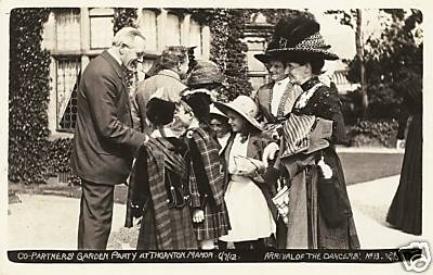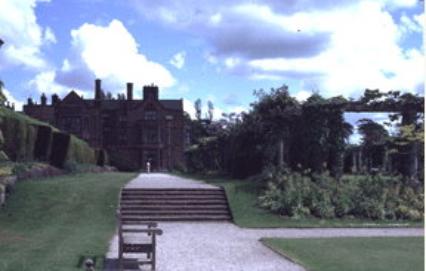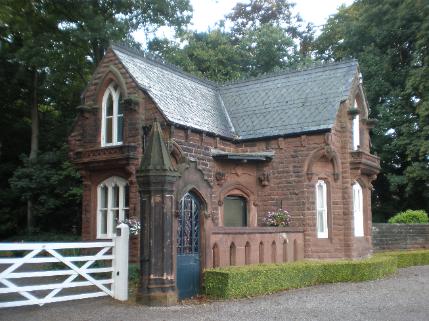

| MENU |

Thornton Manor is a Grade II listed building on the outskirts of Thornton Hough. Since the 18th
century only six families have owned the house and land on which Thornton Manor stands. Until 1849,
the whole of Thornton Hough, including land now occupied by Thornton Manor and gardens, formed
part of the vast Parkgate Estate owned by the Mostyn family from North Wales. At that time, the
lands which housed them manor and it's gardens were fields known as Martins Hey, Mill Hey, Milking
Bank and Mutlow and the area occupied by the woodland and lakes was a plantation.
In 1849 solicitor and treasurer Charles William Potts, of Heron Bridge, Chester, bought the land. The
first mention of a building on the site appears in a tenancy agreement dated 10 years later in 1859. It
is believed that Potts was responsible for building the first manor house although there is no evidence
he lived there and, like many other local landowners, he probably bought the property as an
investment to rent out to tenants.
In March 1863 Potts sold the house and surrounding land, which by now was occupied by gardens, to
businessman Thomas Brittain Forwood, whose family was the first to live at the manor. Local historian
Gavin Hunter believes Forwood was responsible for the house, together with the two lodges and
Manor Cottages later bought by William Lever.
Forwood senior died in 1884 and his son Sir William Forwood – a former Mayor Liverpool and chairman
for the Overhead Railway Company – let the manor to William Lever in 1888 before eventually selling it
to him in 1893. During 1888 William Hesketh Lever, later the first Viscount Leverhulme began
construction of his factory of Port Sunlight and in that year he, his wife Elizabeth Ellen and son William
Hulme Lever moved into the house.
The main entrance to the house was originally on the west side, facing the parkland and woods with
access via a driveway running from the south lodge, which still stands behind the wall on Manor Road.
The park had already been laid out, during Forwood’s ownership – and a series of pathways bisected
the woods that originally contained a simple summerhouse and bridge over a small stream that ran
through the woods.
On April 18, 1893, Lever bought the property and started the transformations, which resulted in the
property as it appears today. Internal and external alterations took place and new bay windows were
created on the front of the house, kitchen, furthermore, service quarters were built and stables added.
In 1902 the music room was added, followed by a temporary ballroom two years later – which is now
the swimming pool – and in 1906 a new entrance porch on the south side of the house was added
creating a new front door to the building. The black and white gatehouse was added in 1910, giving
direct access to the entrance courtyard from Manor Road. Further timber buildings were planned to
surround the entrance court but were never completed due to the intervention of the WW1. In 1913
the Elizabethan style wings were added to the west side of the house creating the appearance of the
building we recognise today.
There have only been three Lords Leverhulme and they all lived at Thornton Manor. The first, William
Hesketh Lever, lived at Thornton Manor from 1888 until 1919 when he moved his main residence to
London. The second, William Hulme Lever, inherited the title on his father’s death and lived at
Thornton Manor with his family until he died in 1949. The third Lord Leverhulme was Philip William
Bryce Lever. He moved into the manor following his father’s death and lived there until he died in
2000, just four days after his 85th birthday. Sadly, under terms of the original title, it could only pass
to a male heir and with three daughters to his name the title died with the death of the 3rd Lord
Leverhulme.
Following his death Thornton Manor was sold in 2001 and the new owners had plans to turn the
building into a high-class hotel and health spa, with outlining planning permission granted in April 2002.
However the property was sold again and while the current owners undertake an extensive
programme of restoration and renovation, the stunning building and grounds are available to hire for
weddings, corporate functions and events.
Further information or bookings are available from the Thornton Manor website here.
century only six families have owned the house and land on which Thornton Manor stands. Until 1849,
the whole of Thornton Hough, including land now occupied by Thornton Manor and gardens, formed
part of the vast Parkgate Estate owned by the Mostyn family from North Wales. At that time, the
lands which housed them manor and it's gardens were fields known as Martins Hey, Mill Hey, Milking
Bank and Mutlow and the area occupied by the woodland and lakes was a plantation.
In 1849 solicitor and treasurer Charles William Potts, of Heron Bridge, Chester, bought the land. The
first mention of a building on the site appears in a tenancy agreement dated 10 years later in 1859. It
is believed that Potts was responsible for building the first manor house although there is no evidence
he lived there and, like many other local landowners, he probably bought the property as an
investment to rent out to tenants.
In March 1863 Potts sold the house and surrounding land, which by now was occupied by gardens, to
businessman Thomas Brittain Forwood, whose family was the first to live at the manor. Local historian
Gavin Hunter believes Forwood was responsible for the house, together with the two lodges and
Manor Cottages later bought by William Lever.
Forwood senior died in 1884 and his son Sir William Forwood – a former Mayor Liverpool and chairman
for the Overhead Railway Company – let the manor to William Lever in 1888 before eventually selling it
to him in 1893. During 1888 William Hesketh Lever, later the first Viscount Leverhulme began
construction of his factory of Port Sunlight and in that year he, his wife Elizabeth Ellen and son William
Hulme Lever moved into the house.
The main entrance to the house was originally on the west side, facing the parkland and woods with
access via a driveway running from the south lodge, which still stands behind the wall on Manor Road.
The park had already been laid out, during Forwood’s ownership – and a series of pathways bisected
the woods that originally contained a simple summerhouse and bridge over a small stream that ran
through the woods.
On April 18, 1893, Lever bought the property and started the transformations, which resulted in the
property as it appears today. Internal and external alterations took place and new bay windows were
created on the front of the house, kitchen, furthermore, service quarters were built and stables added.
In 1902 the music room was added, followed by a temporary ballroom two years later – which is now
the swimming pool – and in 1906 a new entrance porch on the south side of the house was added
creating a new front door to the building. The black and white gatehouse was added in 1910, giving
direct access to the entrance courtyard from Manor Road. Further timber buildings were planned to
surround the entrance court but were never completed due to the intervention of the WW1. In 1913
the Elizabethan style wings were added to the west side of the house creating the appearance of the
building we recognise today.
There have only been three Lords Leverhulme and they all lived at Thornton Manor. The first, William
Hesketh Lever, lived at Thornton Manor from 1888 until 1919 when he moved his main residence to
London. The second, William Hulme Lever, inherited the title on his father’s death and lived at
Thornton Manor with his family until he died in 1949. The third Lord Leverhulme was Philip William
Bryce Lever. He moved into the manor following his father’s death and lived there until he died in
2000, just four days after his 85th birthday. Sadly, under terms of the original title, it could only pass
to a male heir and with three daughters to his name the title died with the death of the 3rd Lord
Leverhulme.
Following his death Thornton Manor was sold in 2001 and the new owners had plans to turn the
building into a high-class hotel and health spa, with outlining planning permission granted in April 2002.
However the property was sold again and while the current owners undertake an extensive
programme of restoration and renovation, the stunning building and grounds are available to hire for
weddings, corporate functions and events.
Further information or bookings are available from the Thornton Manor website here.







| Garden Party at the Manor |
| Manor Gardens |
| The old Gatehouse at the Manor |
| Copley House-Thornton Manor |